
Jimmystats: Free Throw Rate and Stuff

It began with a conversation over Morgan & York sandwiches about why Michigan is always behind the rest of the country in free throw rate. The question is how do players, and teams, consistently "draw" fouls. And it bothered me that the rhetorical answers sounded more like Stephen Bardo/Dan Dakich truthisms than scientific wisdom.
- To the aggressive go the spoils.
- Star players earn respect from the refs.
- You gotta be a man to play in the Big Ten
- Fouling that guy is smart because he's only a 60% free throw shooter
- That's the kind of call you get at home.
Except one. The simple answer is you earn whistles by going to the rim (and Michigan doesn't go to the rim). This turns out to be as true as it is obvious:
An r-squared of 0.35 says these things are connected, but it's clearly not the only thing going on. So I figured I'd do this: substitute an expected free throw rate based on % of shots at the rim, then look at other numbers and see if there are any patterns.
And where better to start than the Dakisms, each with a ring of truth:
- More off-balance defenders around you equals more opportunities for one to foul you.
- The nature of good rim players is they can contort themselves to turn attempted blocks into glancing contact
- The Big Ten does seem to officiate more loosely than other conferences (we notice this at tournament time every year)
- Hack-a-Shaq is a thing, though when you account for the value of a foul to count both against one of your player's five and in the bonus/double-bonus math, it's not quite the 0.60 PPP you think it is.
- Home court advantage is a proven thing, and was a wild runaway thing in the Big Ten through January (a span over which Michigan had the misfortune to play 6/9 conference games on the road).
Not to mention refs are a breed of fallible humans who have their own ideas of what for and when to blow a whistle, and are influenced more or less by yelly coaches, and grew up hating Michigan, and are committed to screwing us because of something Bo said about Jim Delany, and there's a great conspiracy…
Let's try math instead.
[After THE JUMP: Math.]
THE ROUGH AND TUMBLE BIG TEN
In general the major conference schools fared far better with the stripes than the minor conference teams.
There were significant differences between the conferences. The Ivy and Patriot Leagues are officiated as the game was when our great grandads played: if you lose an arm in the lane, you shoot through it. The Big Ten isn't so extreme but is still the major conference most likely to tell one to walk it off. Your standard SEC game on the other hand has more tweets than coach twitter during a Super Bowl.
Anyway that's the last I'm going to talk about the mid-majors. Life down there gets too weird.
FORTUNE FAVORS THE BOLD
So the first thing to do was plug the above regression into the data and see which teams are getting more or fewer calls than you would expect from the frequency they get to the rim. I did this with teams and tried it with players but after about 850 you break Torvik. So these stats are from Kenpom with Rim/Not-Rim numbers culled from Hoop-Math.
The first thing that stood out was the correlation of Much Rim—>Many Fouls was much stronger on offense than on defense. This was a Duh moment: teams that go to the rim are doing so because they're good at rim offense, and teams that prevent shots at the rim are likely deterring those shots because of their rim excellent defense (or becaue they play a lot of zone).
The above sample are Major conference players playing over 40% of their teams' minutes, broken up by height. I found it interesting that the correlation here increases exponentially as you move down the position chart, but it also makes sense: What you're seeing is the difference between slashers who are going to the basket in isolation situations, versus the steadily increasing likelihood of stationary targets. My hunch here is if we had more than free throw rate we'd see a lot of fouls on the floor for the guards and wings (or if we're talking Big Ten, fewer ventures to the basket because everybody can hand-check like Aaron Craft again). Anyway what you're seeing here is the increased likelihood of a defender in the vicinity and attempting to do more than be in the way.
The second thing I saw is the Terps are living the high life.
STAR PLAYERS EARN THE BENEFIT OF THE DOUBT
Anthony Cowan is getting the best whistle in America [Paul Sherman]
Here are the top 25 major conference teams getting a better whistle than their at-the-rim% suggests they should:
The bottom end were mostly terrible mid-major programs that use their entire roster and foul as a strategy. There were two massive outliers from the SEC getting called for so many fouls on defense I wonder if they're doing it on purpose. SC seems to have a whole bunch of forwards with 5+ fouls per 40 minutes.
Purdue and Maryland are the Big Ten's extremes. Purdue is a team that can't get its best two players on the court at the same time because they're both centers, and doesn't get much penetration. Maryland is a team loaded with athletes who go to the rim because they're so good at it. Anthony Cowan is a [meep meep] dynamo, Jalen Smith is a pogo stick at or near the top-100 in every category that takes place above the rim, and they have enough athletes and runners around them that you can't just clog the lane. Right?
the turquoise are Big Ten
There's a relationship, but this was somewhat less than I thought it would be. I was especially surprised that Cassius Winston fell well below the line, however that makes sense when you consider that's more of a volume thing: Winston is money on runners and pullup threes, and small enough that Izzo's managed to keep him out of the NBA all this time, so why would he go banging into contact?
The biggest extremes in the conference were Minnesota's Payton Willis (4.7 FT Rate) and Nebraska's freshman big Yvan Ouedrago (46.9 FTR). Willis is a Just a Shooter who's probably only going to the rim when there's nobody there to contest, Ouedrago is a hideously bad offensive player who shoots 48% from the line and 41% from the field, on a team you don't really need to save your fouls for. The guys who stand out are Jackson-Davis, Cockburn, and Cowan. Those guys have NBA talent and tend to initiate a lot of contact since the Big Ten doesn't call piddly offensive fouls for that (except on Michigan).
When I ran the same regression formula for the players in-conference, even after limiting rim changes to at least 15, it came up with a bunch of low-usage bigs—Cordell Pemsl of Iowa had a +38.1, Maryland's Makhi Mtichell was +31.9, and Penn State's John Harrar was +24.1. I think those are low sample size. Keeping it to just players with 100+ FGAs this year, here are the Big Ten players getting the best whistle relative to how often they get to the rim:
I see a few stars in there—Cowan, Wesson, Jackson-Davis, Cockburn, and Carr—and then quite a few guys who just get to the line. It's at this point we usually throw up our hands and call getting to the line a skill. That might be it, but we're also seeing a lot of not very skilled Buckeyes, plus Connor McCaffery. Let's take a look at the other end:
You'll note quickly that we're dealing with a far less able group of players here. You probably recognize just one or two of them. And that makes me wonder if we're seeing something of a ref effect in here, not necessarily bias against a certain team but bias towards players the officials recognize. So let's filter for PRGG!s over 3.0 (very good players) and see which ones aren't getting the benefit of calls:
Well whaddaya know, it's the guys we like a lot. Some of these guys go to the rim quite often, but you'll note when they do so they're not the guys who seek contact. Dosunmu is the conference roadrunner. Simpson's "rim" attempts are scoops and skyhooks. Teske often tries to shoot a jumper rather than try a post move. And Xavier Tillman is planted to the ground. The odd ones here are Livers, Griffin, and Jones, but they're also guys who generally don't go to the rim much. Again, I think we have more evidence for style.
SO IT'S NOT A CONSPIRACY AGAINST MICHIGAN BUT MICHIGAN'S STYLE?
Other than the Buckeyes you can match the teams that get an outsized FT Rate to those with excellent rim players. You see the teams with Jalen Smith & Anthony Cowan, Luka Garza, Trayce Jackson-Davis, and Kofi Cockburn ranked 1, 2, 3, and 4 in apparent whistle help. If there are certain teams being disliked by refs, that too is overshadowed considerably, at least on offense, by the effect of players with a skill for going up to the rim and scoring through a forest of arms.
However offense is just half of the equation. The defensive FTRate differential gets weird.
You will note the Big Ten skews toward lower free throw rates in general; every team in the conference except Purdue had a defensive free throw rate better than expected given how many shots at the rim are taken against them. Even in that regard, Maryland seems to get quite the benefit of the doubt on defense, and Nebraska is a national outlier:
Some of the outliers were interesting. Syracuse is an extreme zone team, as were some of the other no-rim outliers. Colorado, Colorado State, and Utah came out with some of the friendliest ref situations in the country. Colorado is just a weird team—they're the only major conference team that returned its entire starting lineup (in fact their entire rotation), and feature the frontcourt duo of Tyler Bey, a 6'7" pogo stick, and Evan Battey, who's 6'9" but offensive lineman strong.
Perhaps style has something to do with this? Off the top of my head, Indiana, Penn State, Michigan State and Rutgers are the Big Ten teams known for going for a lot of blocks. Well:
There's a correlation in the Big Ten that fades to only a small correlation when you consider the rest of the Major programs, and disappears altogether once your sample size is the entire country. My guess is there is a small connection that gets buried because mid-majors don't have the talent or size to make blocking a part of their strategy. You can see the difference in the Big Ten between the few in the conference who have those kinds of players, those with maybe one or two, and those who don't. Illinois is a run-out team that will try to go for steals, not wall up the basket. Nebraska is undersized. Northwestern is under-talented.
The middle has a bunch of teams that play drop coverage, and a defensive emphasis on forcing low-efficiency shots. That style of defense doesn't just push offense away from the rim, but dictates which players get there.
Again it's Maryland I find interesting here, because I think there is a difference in how stars are officiated on defense. It's hard to show it with data, but anecdotally, Cockburn gets away with a lot more contact because every foul on him could affect Illinois dramatically. That's true as well for Smith and Cowan, though Maryland's athleticism and Smith's excellent defense also tend to force more bad shots.
Purdue was also the only school to come out significantly hosed by officiating, with Maryland, Iowa, Indiana, Illinois, Nebraska, Wisconsin, and Ohio State all about five favorable calls per game better than rate you'd expect for how often they get to the rim. (These data were also taken from before last night's Maryland-Northwestern game, when poor Northwestern got within four and all of a sudden every guy who came near an Anthony Cowan drive got whistled, so if anything it's more extreme now).
SO WHY IS MICHIGAN ON THE GETS DOINKED LIST?
For years under Beilein Michigan was exactly the kind of team that's selected against by all of these factors. They don't tend to get one-and-done 1st rounders who trust their athleticism against contact inside like Maryland. They don't seek contact. The conference itself allows more contact than any other major. When you look at the individuals it makes sense:
- Brandon Johns is the team's most natural athlete, and he's getting a fair whistle.
- DDJ is pretty athletic too and would rather shoot floaters than try to get a layup through contact.
- Teske shies away from contact, and goes for fadeaway jumpers when he's matched down low.
- Brooks isn't a great finisher and rarely goes to the net when not on breakaways or things set up by the offense.
- Livers same.
- Simpson's shots at the rim are mostly scoops and hooks, which like Teske's fadeaways are moving away from contact.
- Wagner gets a crap whistle. Maybe it's because he's still small, or not used to the Big Ten, or because he makes faces at the refs and they remember his brother too well.
- Austin Davis is glued to the floor but he's an extreme at-the-rim player and probably should be getting more calls, particularly and-ones. It might however just be that his shooting percentage is so high down there.
- Adrian Nunez is a low sample size in garbage time, and has many of the issues of the guys above too.
Beilein's rosters were filled with Not Just a Shooters, and this remains a Beilein roster. Also Franz gets screwed. The end.
February 20th, 2020 at 12:34 PM ^
For basketball should these be called, like, Juwannystats?
February 20th, 2020 at 2:00 PM ^
Thought about that actually.
February 20th, 2020 at 12:37 PM ^
My god is this f'in good. Hats off. Will return to read with more care.
I wonder what the rest of the hoi polloi and cognoscenti think we should do to compensate against MD in their stanky home arena in the season-ender. Obviously the first answer is to smite them with our vorpal sword.
February 20th, 2020 at 12:46 PM ^
That's nice!
BUT WHAT ABOUT RECRUITING ?
This is nice though...
February 20th, 2020 at 1:46 PM ^
This isn't rocket science stuff. As the sophomore PG at Pinckney High in the '68-'69 season I attempted 180 FTs in an 18 game schedule. My high was 18 AT Leslie who was ranked #1 in class C-at the time. (And they continued to be #1 until late in the season when we pounded them at our place-and ended their 50 game regular season winning streak.) I had the green light to go off-script and penetrate at anytime. I looked for seams of advantage and first and foremost drove for/to create contact that I could take advantage of and either score or set up my teammates. I pretty much see nobody doing this on this team. I view this as basic, fundamental play for anybody-certainly for a PG. As I began, this isn't rocket science stuff.
February 20th, 2020 at 2:31 PM ^
Wow you got 18 FTs @ Leslie??? I'd love to hear more. You sound really awesome. Too bad X isn't as good as you.
February 20th, 2020 at 10:02 PM ^
I would tell you more but you very likely don't have any knowledge from which to understand even the most basic aspects of this game. My guess is that you are making fun of the competition level. We played in a pretty competitive league. Jesse Campbell, Stockbridge, was in my class. He was a 6'11" HS All American center. I returned to Indiana for my senior year and played against a kid who went on to be a college AA and played in the NBA and another kid who is in the IN Hall of Fame. It was smaller school ball but the play was very competitive and if you didn't show up you got your butt kicked. So, the fact is, I have played against a lot better players than X. You-I doubt it..probably didn't even play.
February 20th, 2020 at 3:24 PM ^
It's not a surprising result, but remember "common sense" is commonly wrong. So it's good to have objective analysis to confirm even the most reasonable hypothesis. We can't advance very far in our understanding of things based on anecdotes, no matter how convincing they might seem to us.
February 20th, 2020 at 9:47 PM ^
It is exactly opposite of what you evidently believe. This is a heavily nuanced game. Statistics only tell you what happened-they tell you absolutely nothing about why it happened. (I see the DDJ pass that got intercepted for a layup getting a lot of attention-nothing coming close to correctly assessing what happened on the play.) Stats are useful for objectively informing you of strengths and weaknesses-that is all.
The winning edge/difference in sports is what happens beyond "common sense" and the "status quo". All good players and teams do the regular stuff well but the great teams and players win by doing a couple extraordinary things well too. But again, stats give no instruction regarding why an extraordinary play happened. The better teams optimize their potential-they rebound, shoot, draw fouls, create turnovers...at better/higher rates...they know how to hedge advantages for themselves. Fans complain all the time about certain players and teams always getting a whistle advantage-they get it for good reason. Learn how to play the game.
Another point: I was not/am not a fan of Beilein's overall style of play but I am a huge fan of how he taught his players to do a whole lot of "small" fundamental things that pushed a ton of "nuance" in his favor. This is why he was able to successfully compete against more athletic teams. And the great irony here is that all the fans point to the statistical advantages he often carved out but they don't have the faintest idea of how those numbers came into being.
And finally. It is simply an athletic contest. I love watching the games from my perspective and I hope y'all enjoy watching from yours. I have to put up with "90%" of the stuff that gets posted here...I think it's only fair that you put up with the other "10%" of the story.
Juwan Howard is one hell of a coach...and the part that should scare the crap out of his opponents is that he is going to get better.
February 20th, 2020 at 1:47 PM ^
An R squared value of 0.35 is not necessarily "connected".
February 20th, 2020 at 1:56 PM ^
Yeah I had to log in to weigh in here (not that anyone asked).
R-Squared should be interpreted as the % of the dependent variable that can be explained by the model. Anything less than 0.5 is basically worse than random chance. There is no correlation, and presenting it as such is misleading.
I get that this is a sports blog, not a science publication, but if we're going to try to use advanced statistical techniques to make a point, let's not misrepresent the results for the sake of a one-off article.
February 20th, 2020 at 4:42 PM ^
Thank you. Sorry I got it wrong.
IIRC the r2 got up to 0.45 with just the major conf players playing 20%min+.
February 20th, 2020 at 2:39 PM ^
Love this, great maths. Only one correction, Nunez's minutes are not in garbage time unfortunately...
February 20th, 2020 at 2:51 PM ^
I don't think it is a conspiracy, however Big Ten officials in a general sense are just dog crap. At the end of the day the only loss in the last 7 was a game that was decided by a ridiculous call that had no basis to be called. That is interesting that Winston is not actually that great at drawing fouls, could have fooled me with how many trips he has taken to the line against UM in the last 5-6 games.
February 20th, 2020 at 4:32 PM ^
Without a way to remove end-of-game intentional fouls, there will be a bias toward teams who have found themselves leading in the last few minutes and away from teams who have been trailing. It could explain some of Maryland's whistle luck.
February 20th, 2020 at 5:14 PM ^
I find this interesting, though I do still feel like the list of Dakich stuff still factors in somehow that is hard to capture - home crowds, bully coaches, star players, etc.
Here's what I can't figure out though - this current roster of Michigan players fits your narrative about getting to the rim. In Trey Burke's POY season I don't think he got nearly the whistle you'd expect when he'd attack the rim. In Derrick Walton's senior season he didn't get those whistles either. Perhaps neither was the athletic dynamo that Cowan was, but still thought they never got the benefit of the doubt at the rim.
I watched some of Maryland last night and their offense basically turned into "Cowan goes really fast at the rim and either gets a layup or the refs give him a call."
February 20th, 2020 at 10:37 PM ^
Excellent work. Thanks for doing the analysis.
February 21st, 2020 at 11:46 AM ^
There’s a lot to digest here and but overall I think it helps reinforce the idea that Michigan doesn’t draw a ton of fouls based more on style than an unfair whistle.
Seth makes great points about the individual players on our roster and why they don’t draw more fouls. As for Franz not getting a fair whistle, I agree that it’s a strength issue more than anything. Franz is still just very weak with the ball when he drives that it doesn’t always look like a foul because he can be stripped so easily.
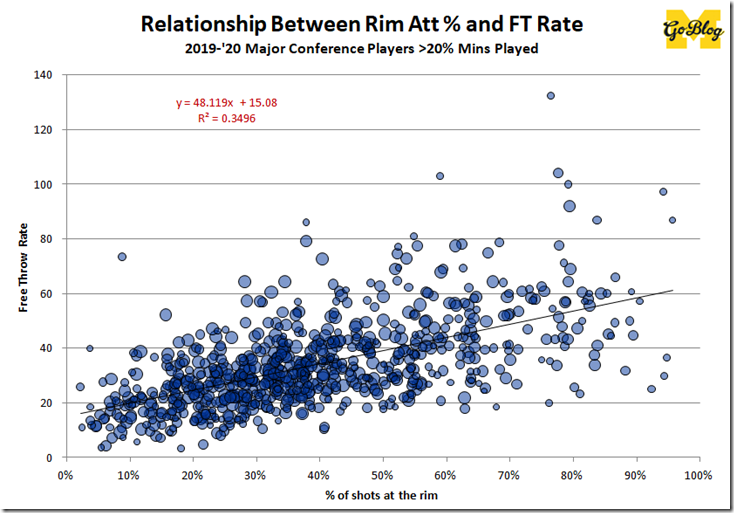

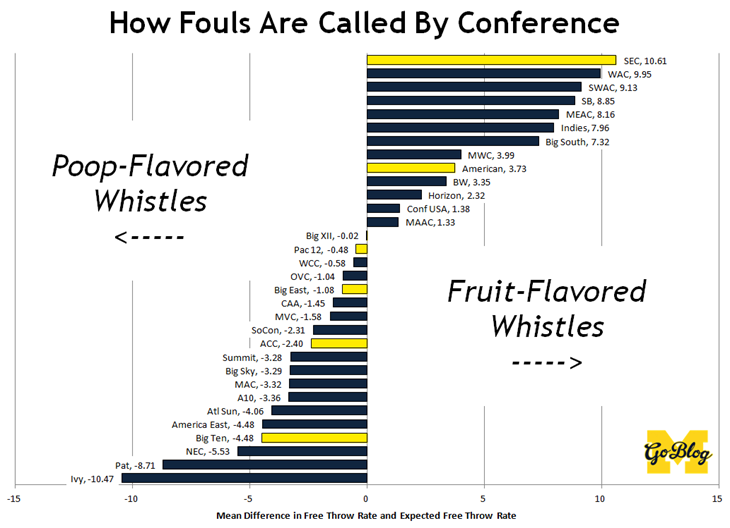
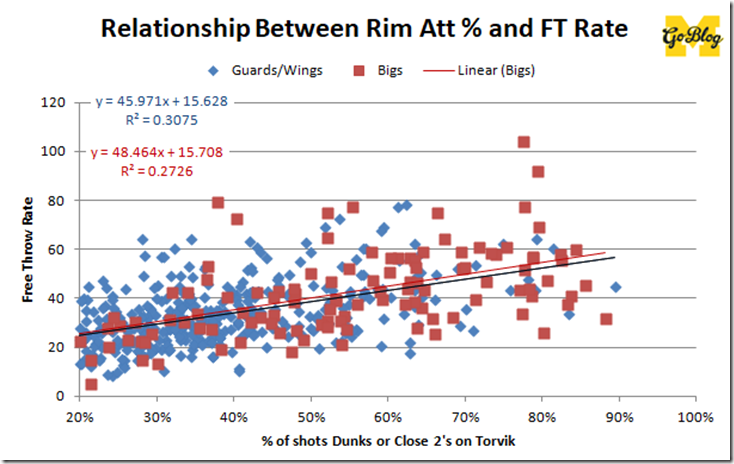
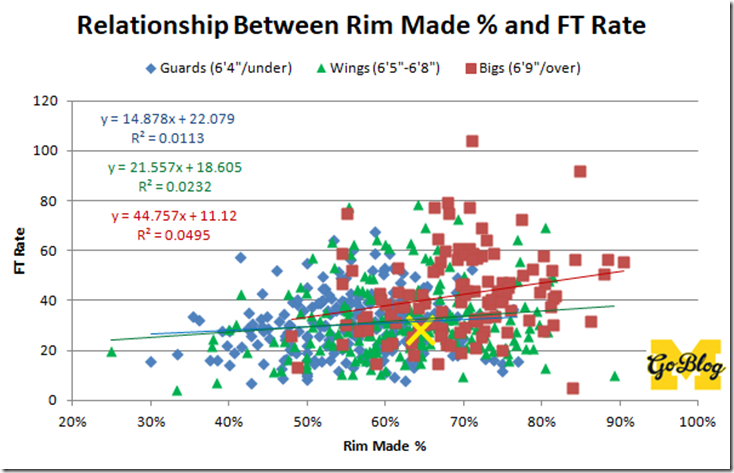
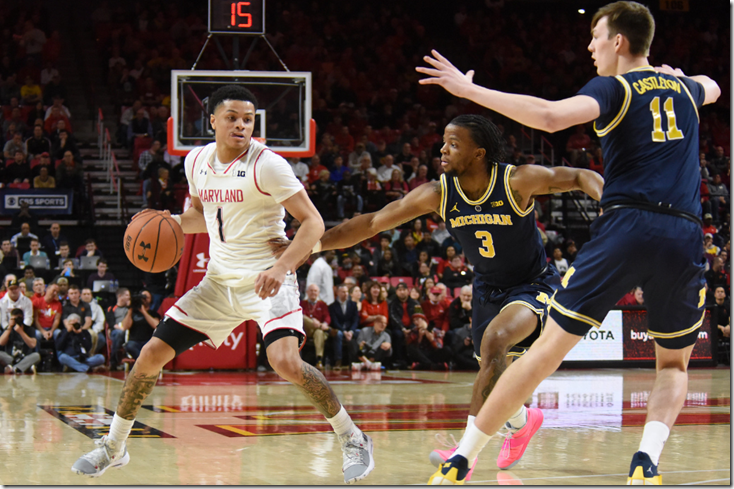
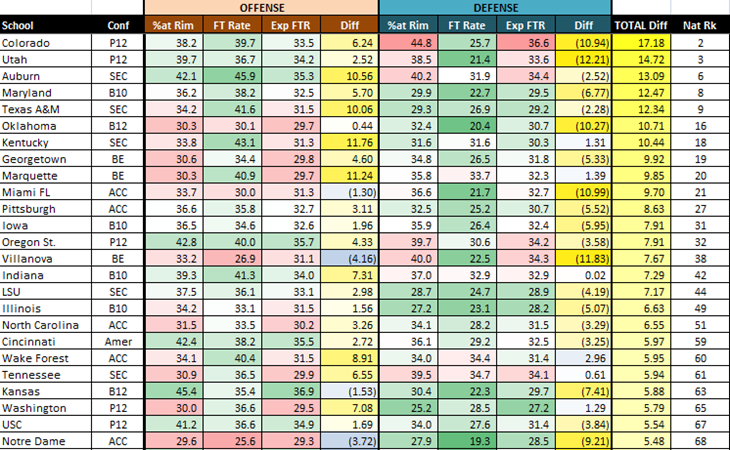
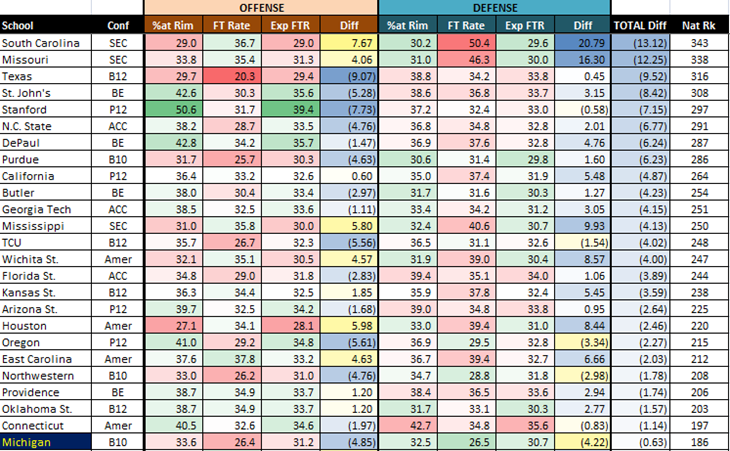
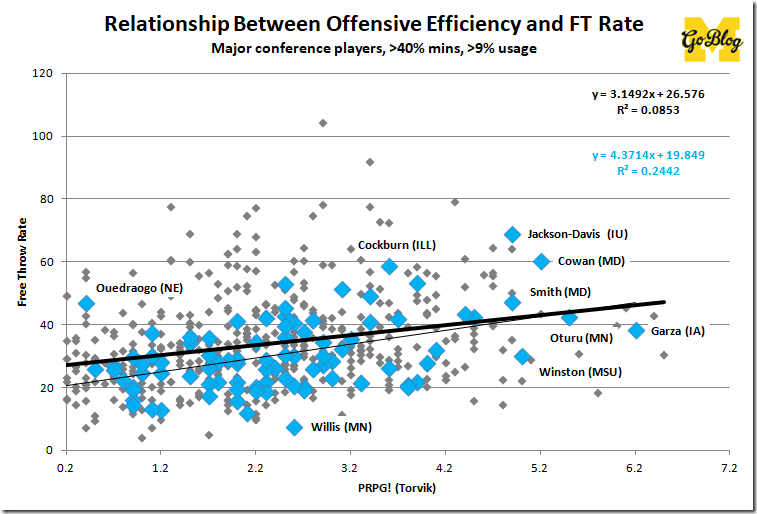



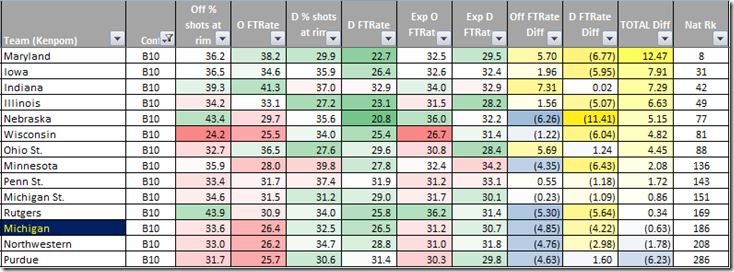
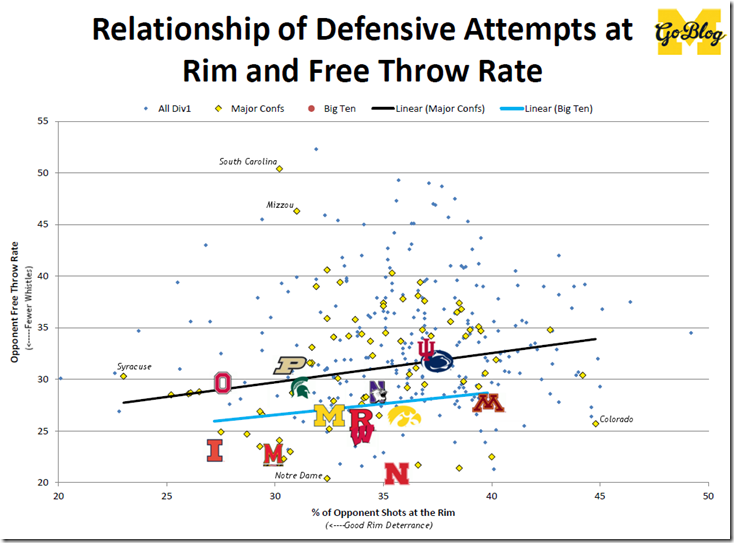
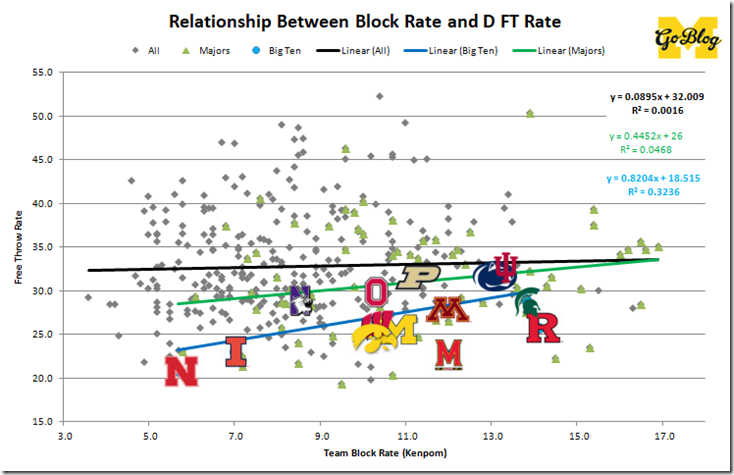
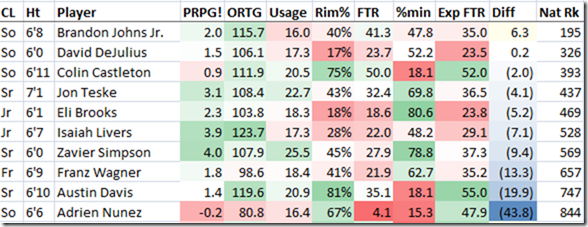
Comments